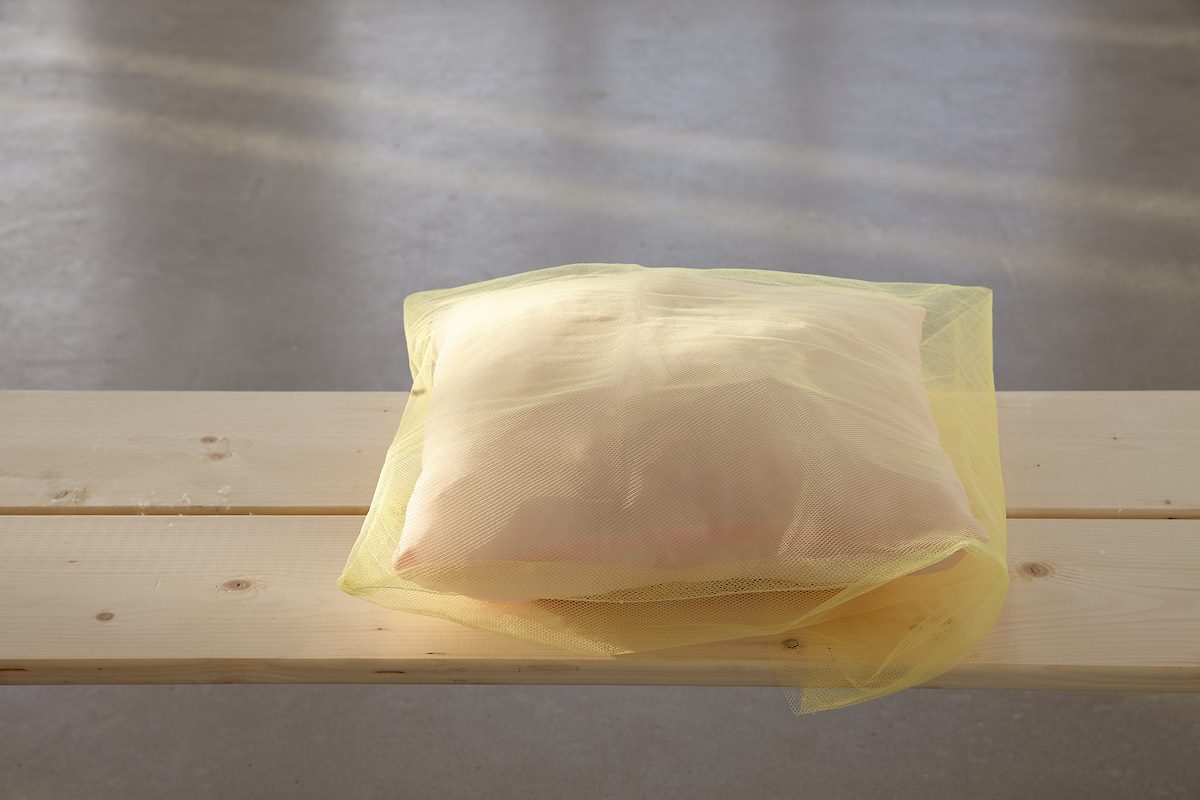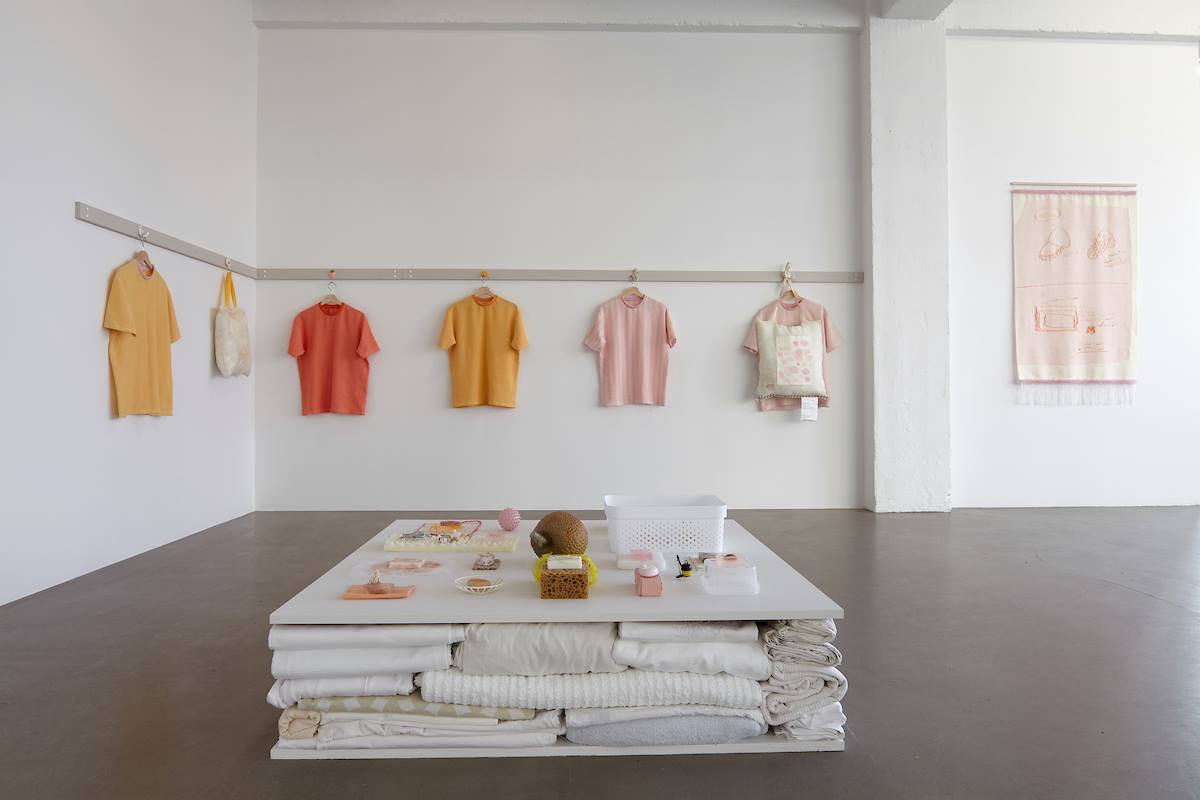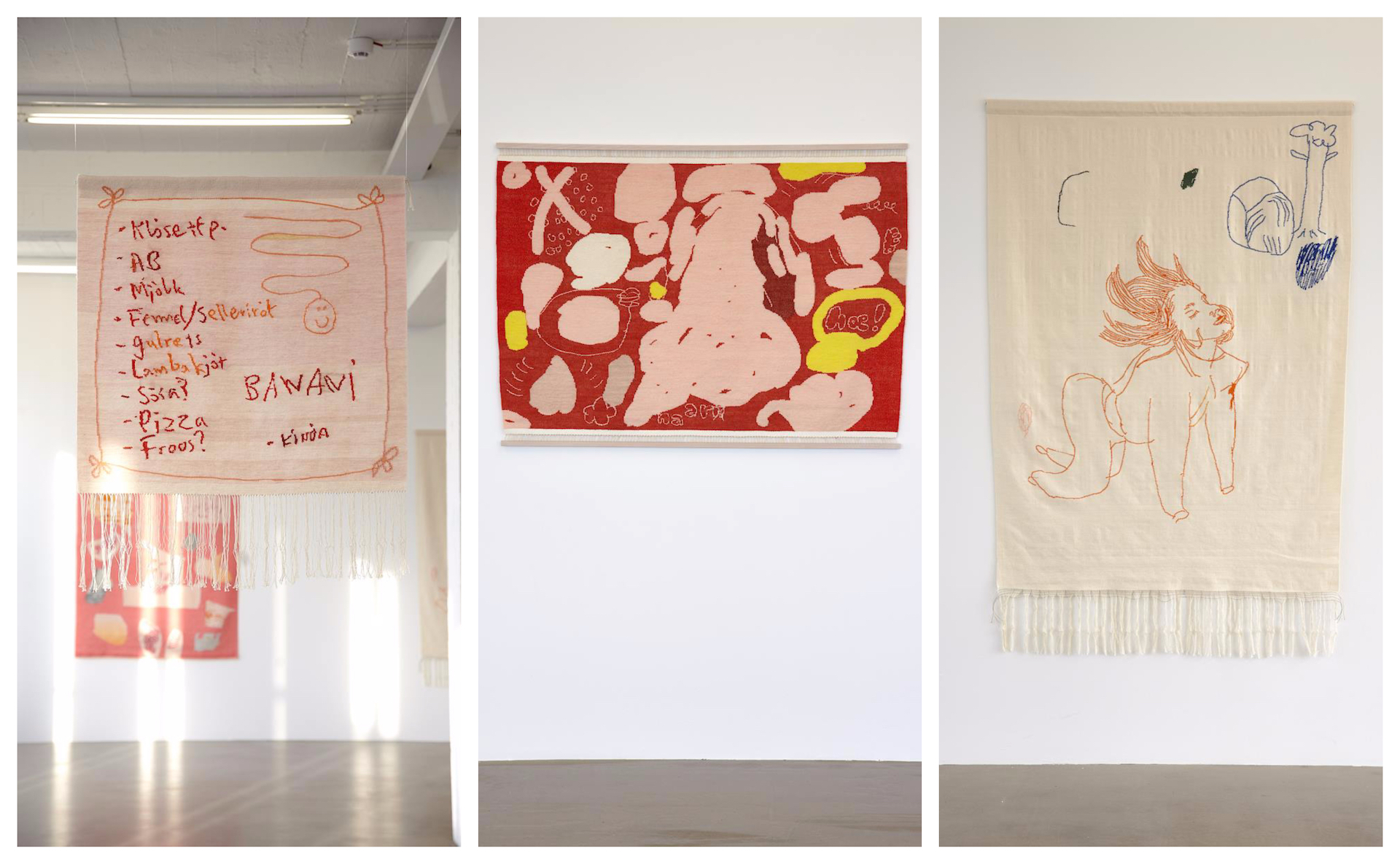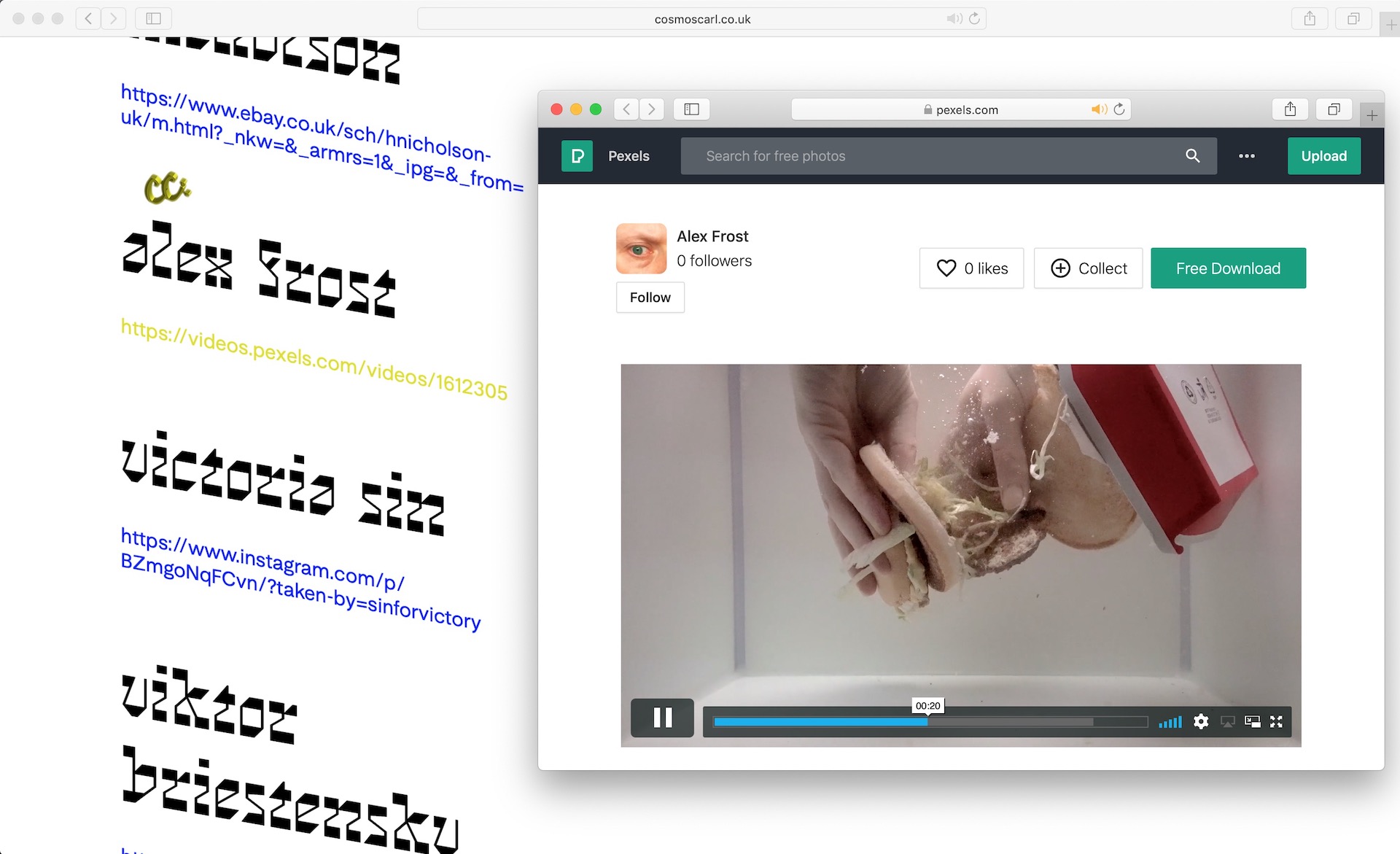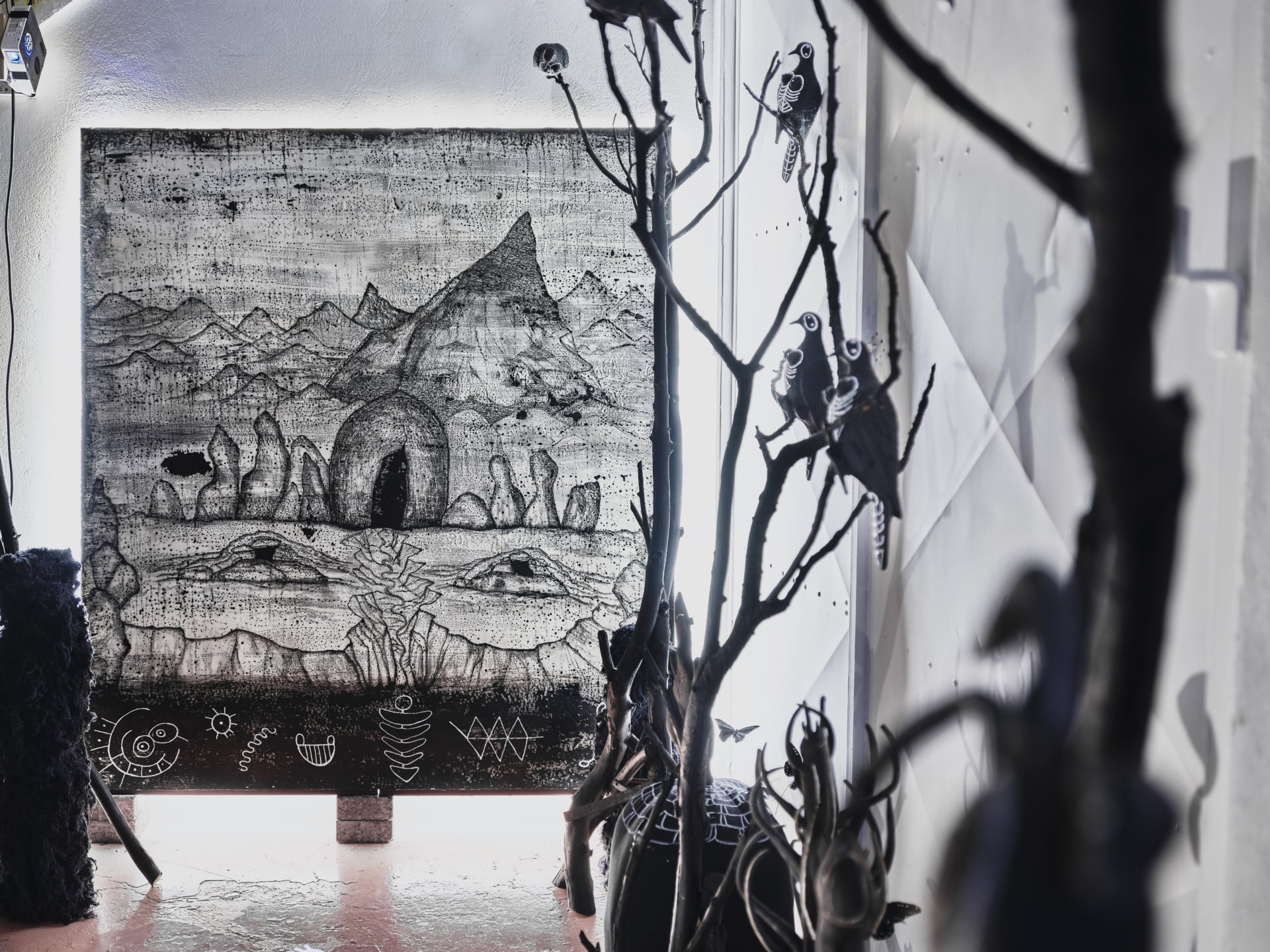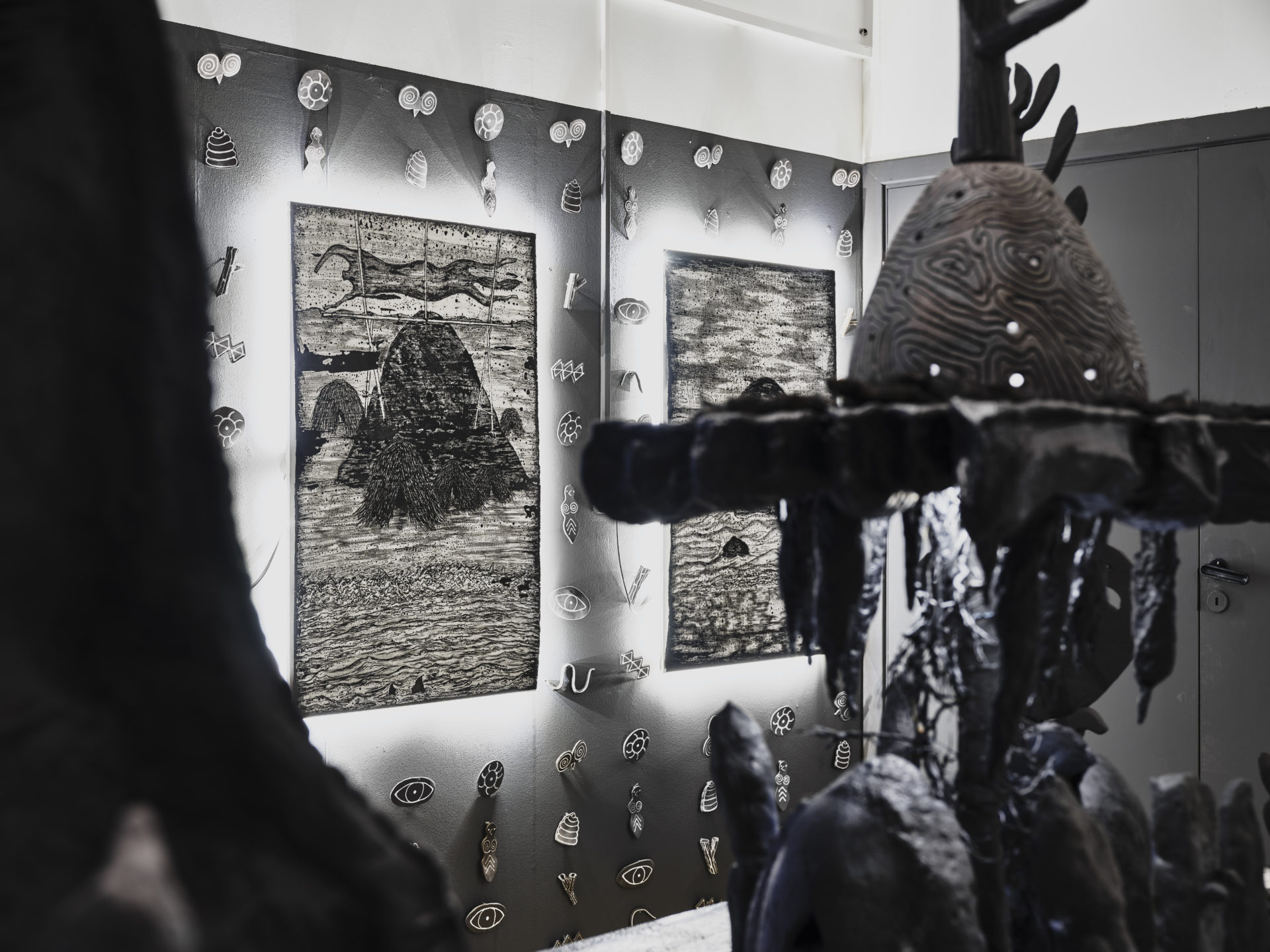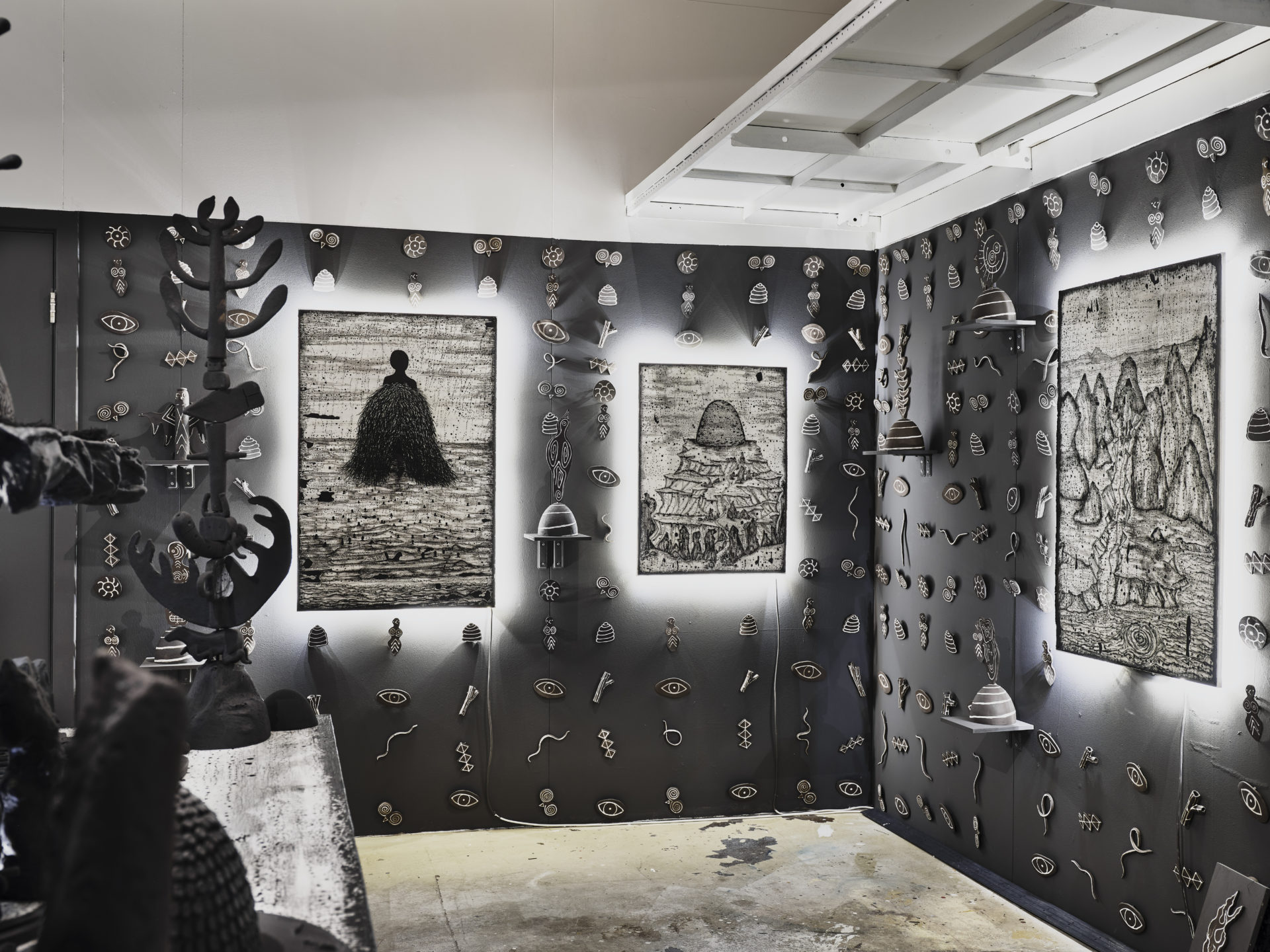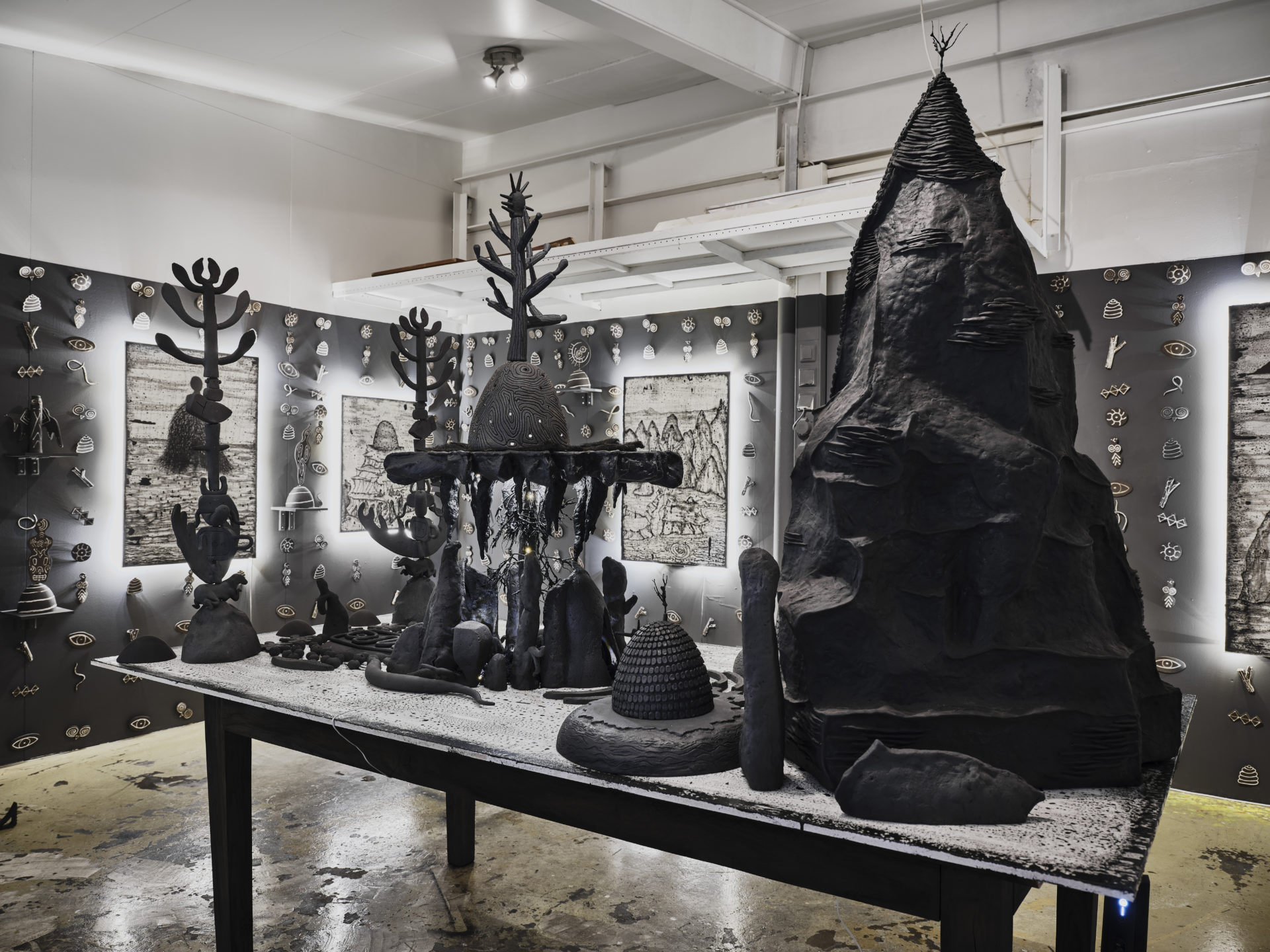Cosmos Carl is a project by artists Frederique Pisuisse and Saemundur Thor Helgason. Their website can be described as an artist-run online exhibition platform that celebrates the democratization of the web while unveiling its potential when it comes to presenting artworks. Frederique and Saemundur are both based in Amsterdam, where we met to talk about the ongoing voyage of Cosmos Carl.
B: When and how did the Cosmos Carl adventure begin?
F+S: It started after we moved in to our first apartment together in 2014, along with two other people who are both curators. Two artists, two curators in one house. There was a separate room in the house that we thought to do something with, like hosting exhibitions or artists’ projects, which in the end didn’t work out. So we resolved it by doing something online instead. When we started out we saw Cosmos Carl as a response to the net-art at the time, which was very code-based. This made the presentation of art very difficult if the artist didn’t have experience in coding. Artists were already using platforms like YouTube and Vimeo to distribute and present their work online, but mostly through their private artist websites and portfolios. Cosmos Carl became a way to use these existing platforms to explore the online presence of artworks and a way to critique platform-based capital by misusing them for art.
Our first project was with Icelandic artist Styrmir Örn Guðmundsson, and it was our contribution to the Frieze art fair of 2014. We made a film with him and originally hosted it on a special Cosmos Carl Vimeo page. Styrmir’s video recalls an encounter he had while buying fried chicken from a street vendor. At the same time the story is told, he navigates a little trip from an apartment, to the market, and to the vendors house where a humorous exchange of deals takes place. The visualization of his trip happens on Google Maps. It was after this project that we realized the full potential of Cosmos Carl, and the video was later moved to Styrmir’s own Vimeo account and presented as a hyperlink on the CC website.
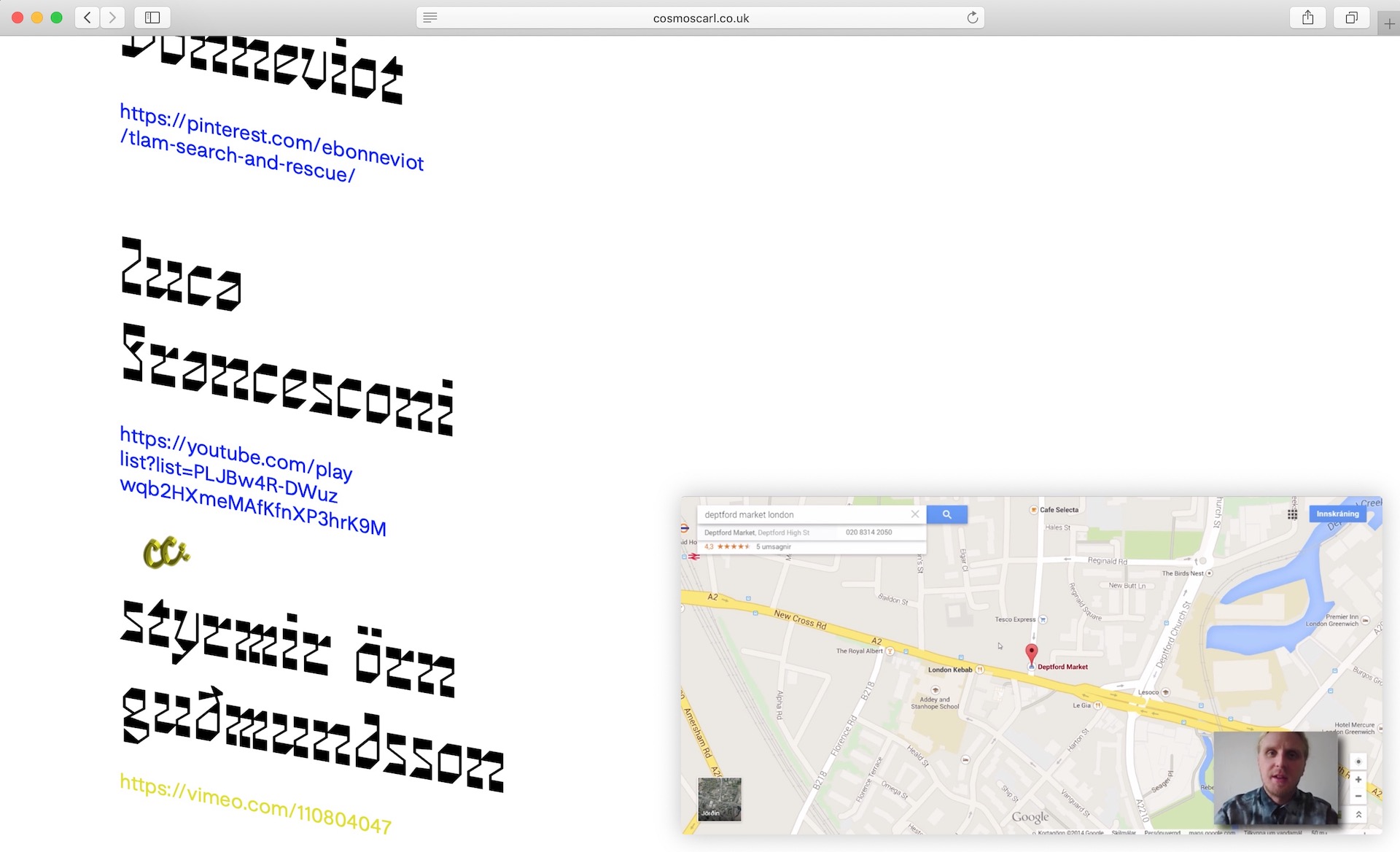 Calling you from Cosmos Carl (2014) by Styrmir Örn Guðmundsson.
Calling you from Cosmos Carl (2014) by Styrmir Örn Guðmundsson.
The name came to us while watching the Cosmos series, made by Carl Sagan in the 80s. I (Frederique) kept referring to the show as Cosmos Carl, and it seemed to fit with what we were doing by creating an online exhibition space. The internet is often perceived as this infinite, non-material thing but vast enough to cruise around as Carl Sagan does in the series. Our intention is to expose and show our visitors corners of the web they wouldn’t necessarily see otherwise.
B: What advantages do you see in artists using these pre-existing platforms versus the traditional artist-as-coder approach when it comes to presenting art online?
F+S: We were already using platforms such as Google Drive and similar apps to communicate and work through. We find them interesting because the politics of those platforms are much more embedded in to the fabric of the world wide web. When we started, we thought net-art was really formal, in the way that artists were using code and software to create images and fictional worlds, almost like paintings and sculpture. We are interested in seeing art being presented online in a more casual way, within the flow of browsing social media sites or eBay. It’s important for us to see art contaminate and be a part of our every-day internet usage.
B: When I visit the Cosmos Carl website, I feel as if I’m at a virtual transfer station… I enter it, and I am immediately sent back to other, often more familiar interfaces. How do you see artworks contributing to this flow of images we are so strangely accustomed to?
F+S: The language of the Cosmos series has provided us with a good analogy, for the viewers travels through space on Carl Sagan’s voyager. Experiencing the Cosmos Carl websites means navigating through a constellation of artworks which exist on different platforms. It’s like a cross-section of the web, and more like a map in this sense. The page directs our visitors to platforms and content that they don’t usually belong to. From the perspective of the platforms that host some of the works it’s difficult to figure out what the interests of visitors arriving via Cosmos Carl actually is.
The online art crowd is pretty undefined to the platforms if you compare it to their subscribers and daily users. We see art occupying these spaces as part of our process to reclaim space for art and democratize the web. Artists used to feel hesitant by showing their work online because of the border that coding created, but in reality, artists use the internet as much as anyone else in their research and free time. As a consequence it has become much easier for artists to imagine their work online if they imagine it belonging to this flow. We encourage them to display their work as they would like to stumble upon it in their act of browsing online and contribute to this flow of data, images and sounds…
It’s been over a year now since an artist has supplied us with a link to their own website and sadly, most of those earlier contributed links are offline by now. In one case, a porn site actually bought a domain name once owned by Nicolas Riis. He made this website and named it cleancare.club It was a beautiful website with his research material and objects that belonged to his thinking process. it was actually a type of object porn. Then he stopped paying for it, so the domain name was taken over by this porn site and for a while Cosmos Carl was temporarily presenting Nicolas Riis’ contribution as a porn site!
It’s currently offline again, but I’m sure the domain will get another resurrection. Actually, now it has become a sort of video platform! Dropbox, eBay and the like just stay online however. The biggest websites don’t renew their links, the URLs just get longer. One work was actually presented as a poetic tour through a fictional apartment on AirBnB! No one has yet reported it as a fake place, so it stays there, which is a really fun thing.
 To sell a river? (2016) Josephine Callaghan
To sell a river? (2016) Josephine Callaghan
B: It’s very beautiful to think about art belonging more and more to the gesture of browsing the web… Jorik Amit Galama’s work is hosted on liveleak.com, and it’s interesting how the work appears next to advertisements, click bates and videos that could relate to his film called Cateater. Do you think it can take over at some point? What’s the influence of art taking up online space, where does it lead, besides a more inspiring and cultured web experience?
F+S: We believe we are continuing the trajectory of culture jamming, a movement which has its roots in activism. Google and YouTube are “bad” corporations, but we use them anyway. By using them you are forced to agree to their specific terms and conditions which concern your privacy online. We see Cosmos Carl as being quite mischievous because it uses the platforms in an unintended way. Culture jamming made use of already existing advertisement images to alter them and therefore shift our understanding of corporate identities and capitalism. We like the idea of using these existing platforms in an unintended way, to undermine and critique them.
 Cateater (2019) Jorik Amit Galama
Cateater (2019) Jorik Amit Galama
Jorik Amit Galama’s film Cateater is a good example. The work is an essayistic film and poem which pops up on the very dodgy platform liveleaks.com. The platform allows for very violent and disturbing content, and Jorik’s contribution to Cosmos Carl involves uploading a video to liveleaks that responds to it in a way that hopefully confronts its daily users and their addiction to this unhealthy material. The impact is probably more if you don’t get introduced to the work via Cosmos Carl, but stumble upon it through its clickbait title Cateater. It’s interesting for us to see artworks in these different contexts of the web and claiming space there in a gesture of disruption and critique.
Few contributions are really on the edge of our own ethical borders. One piece took place on a sex workers platform named myfreecam, used by two artists who were raising funds for a future exhibition. The piece consisted in them doing live nude drawing in front of a webcam. The concept was that they were wearing socks, and I remember there was a dog involved as well. Viewers could therefore attend the event, chip in and ask for specific drawings. It is of course very different when you enter these kind of chatrooms with the interest of looking at it from an artistic perspective to a perverted one. That line really blurred there and we felt the work confronted notions of the male gaze by dealing directly with a platform that encourage it. In a way, it’s interesting to think about these two different groups coming together in a chatroom like that, and all of them being anonymous as well.
When you visit this link now you are redirected to Camilla Rhodes’ profile on this platform. She is the alter ego of an artist from Mexico who finances a part of her practice by doing these types of performances.
 Nude with Socks (2018) Camilla Rhodes and Zoe Claire Miller
Nude with Socks (2018) Camilla Rhodes and Zoe Claire Miller
B: Cosmos Carl is accessible 24/7 and provides visitors with a private experience of art. How do you feel about the accessibility and intimacy the web provides? How does it influence your visitors?
F+S: It’s tricky with online art. In a way it very much conforms to the on-demand attitude, but at the same time it’s not a social act. We feel like people might ignore Cosmos Carl for a few months and then come back to it to binge artworks. Just statistically speaking, people spend around 3 minutes on average on the site itself, before they embark on the journey provided by the hyperlinks that are there. It’s a very light site with almost nothing on it, and therefore becomes a pretty easy task to immediately jump out of it as soon as you enter.
B: Can you tell me how the design of the site came together?
F+S: We borrowed the design from the Werkplaats Typografie (Arnhem) and the typeface is made by Gabríel Markan, also known as Gnax Type. The typeface, available through the Cosmos Carl website, mixes references to digital aesthetics and traditional calligraphy. We like it because it makes the interface and design of Cosmos Carl very unfamiliar and therefore fits with this idea of being a portal.
B: I’m curious to know how an online opening works, and how you introduce yourself to the rest of the web?
F+S: We have a launch every other Friday. There is a ritual which takes place with the introduction of each new link. It’s good for us to keep it rigid. Adding works to the site is practically as simple as sharing a link. We announce each new work on Facebook with an event, and afterwards the links exist on our page as undated, infinite hyperlinks. We feel positive about branching out through interviews and doing more things in public, hopefully belonging to more intricate networks of websites. People are going to be led to our page via artzine, which is a great thing. A Wikipedia page would also be helpful.
We had a contribution as part of a collaboration with the Young Art Biennial in Moskow with Art+Feminism. They are a group of online activists who edit and add pages about women artists, writers, thinkers, musicians, and the more forgotten female figures in history. This needs to be done because Wikipedia is sadly a very male-dominant place. If you look at any male writer who has done something and compare it to a female one, there will undoubtedly be more information and praise about the male one. It’s also very likely that the woman you’re looking for doesn’t even exist on Wikipedia. How we present ourselves outside the CC website is something we are thinking about now, and hopefully we can find a solution to integrate more creatively into people’s calendars. Facebook served us well so far, but we feel there could be a more old-school, analog way to announce the launch of each new link. To be resolved.
B: …and how do you tackle issues relating to the lifetime of the page and the links provided?
F+S: Rhizome started a service which lets you record websites. It started by archiving the net art works from the 90ies and records them in a way that enables you to experience them in the technological context of the time. For example, Constant Dullaart made a work which used Google, and when you visit the piece through Rhizomes archive, you see the work through a browser from that time. You see the piece in its original quality and resolution.
You can do it to your own page as well, and we’ve started archiving Cosmos Carl through their service. The archive of the internet (archive.org) has also been archiving the internet, but in a less precise way. It visits every single website every now and then, and skims over it while taking screenshots. It then creates an overview of the development of your website through screenshots, which you can of course download in case you want to make a biography about your website. But Rhizome is more precise and works better for what we need, it enables us to record the whole website experience with all its links.
B: …So online archiving methods lets you store entire websites similarly to how you store image information inside a .jpg file?
F+S: Precisely. We were wondering if Cosmos Carl needed to be archived, or if we should just celebrate the temporal nature of the internet. The more a link is shared, the longer it lives. But links die out, websites disappear. There are companies which maintain everything very well, but even there, images take up a lot of space and disappear for no reason. No one knows where they go.
As far as artworks go, well, we think it’s important to see them as just being a part of the internet. We decided to start archiving Cosmos Carl because we are making a guided tour through the website that places it within the context of what is happening in the world of platform capitalism today. Capitalism is becoming more and more platform-based and we are interested in reflecting on what the status of art works are within that process. Our work speaks of these less-obvious layers of the internet, but in the subtle activist way that art does. We are able to critique it while being the users of it.
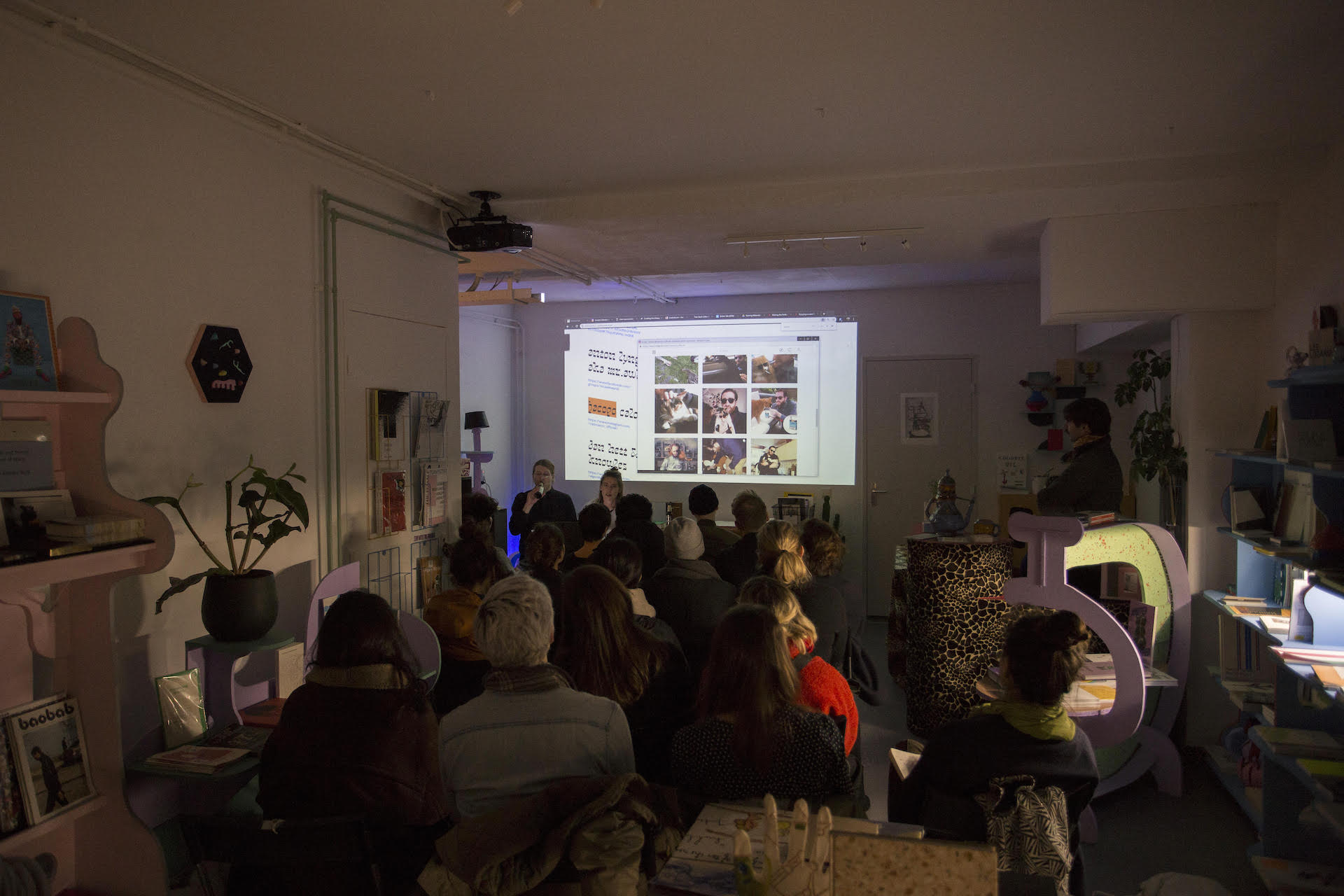
B: You recently did a presentation (at Page Not Found in Den Haag) in the context of the website being a publishing practice. How does the notion of publishing strike you as a part of Cosmos Carl’s qualities?
F+S: We believe that the notion of publishing has been inherent in the workings of CC since the beginning, but we are only finding out now through these interests coming from other publishers. We use these opportunities to give lectures and talk about the works we have on the site, and we are happy to be branching out at the same time we are starting to archive and preserve the websites qualities.
B: It’s interesting you are branching out more and more in to offline territory. What are some of the upcoming activities of Cosmos Carl?
F+S: We have an opening at Banner Repeater in London on the 26th of April. It’s great, because the space is actually located on the platform of a train station! Banner Repeater is an exhibition space and a bookstore, and we were invited to make an exhibition with them around the notion of online publishing. We will show a video where a guide takes the viewer through the city of Amsterdam, with characters entering the story and presenting different parts of Cosmos Carl through their smartphones and tablets.
Our plan is to go through public and platform-based spaces to further elaborate on the blending of offline and online living, and how that distinction is becoming less and less relevant today. For us, those two experiences are constantly merging, and it’s a bit scary what is happening today with state- and privately owned platforms merging in to more fluid entities. It is becoming a bit like a Black Mirror episode.
In parts of China they have actually started doing everything through the phone. You pay for everything with it and what you do online and offline is running together in to one coherent story. That’s one extreme of it and we plan to show another, which presents situations in real platforms such as libraries and public squares while browsing our platform-based website.
In the work we will also visit an exhibition space in Amsterdam where Alex Frost’s piece, ‘Wet Unboxing (Big Mac)’ 2018, will be on view. Alex presented the piece on the website recently, and this part of our voyage is made to compare an online exhibition experience to an offline one. The video is still in the making of course, but we want to create a Carl Sagan-inspired voyage which presents the story of Cosmos Carl as an entity which merges offline and online living and explores the status of the artwork within the age of platform capitalism.
Bergur Thomas Anderson
www.cosmoscarl.co.uk
Featured image: Wet Unboxing (2018) Alex Frost
